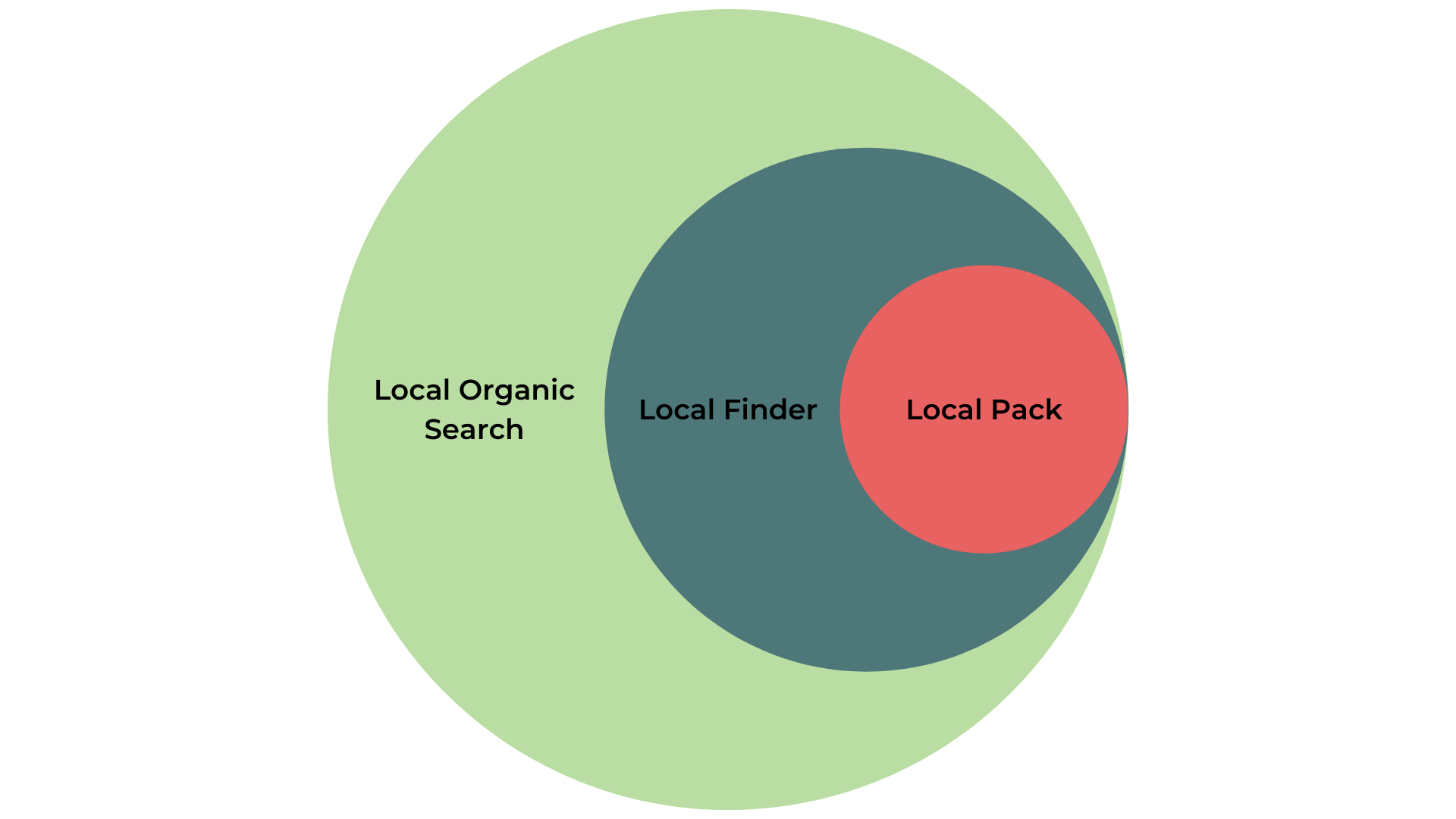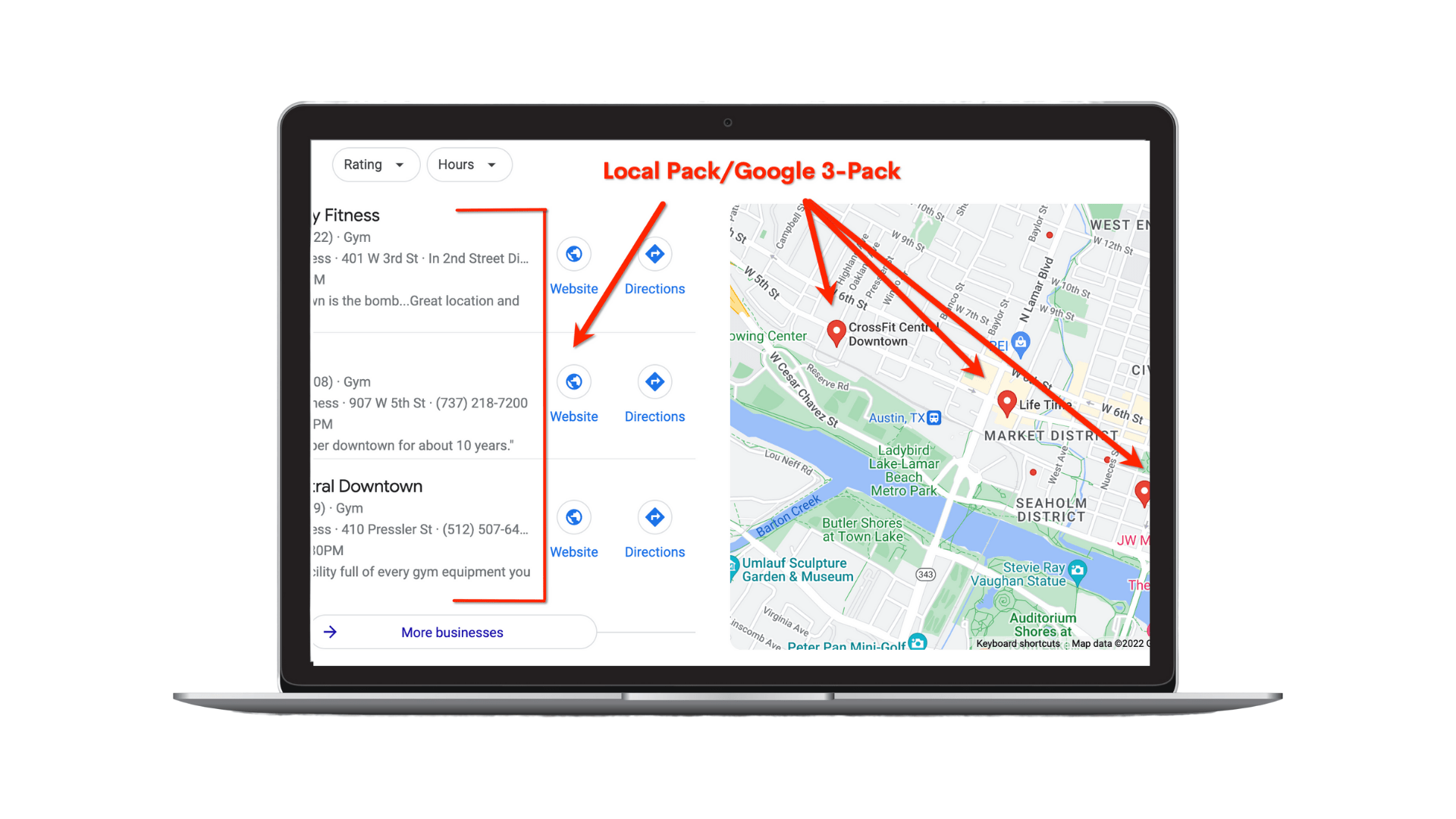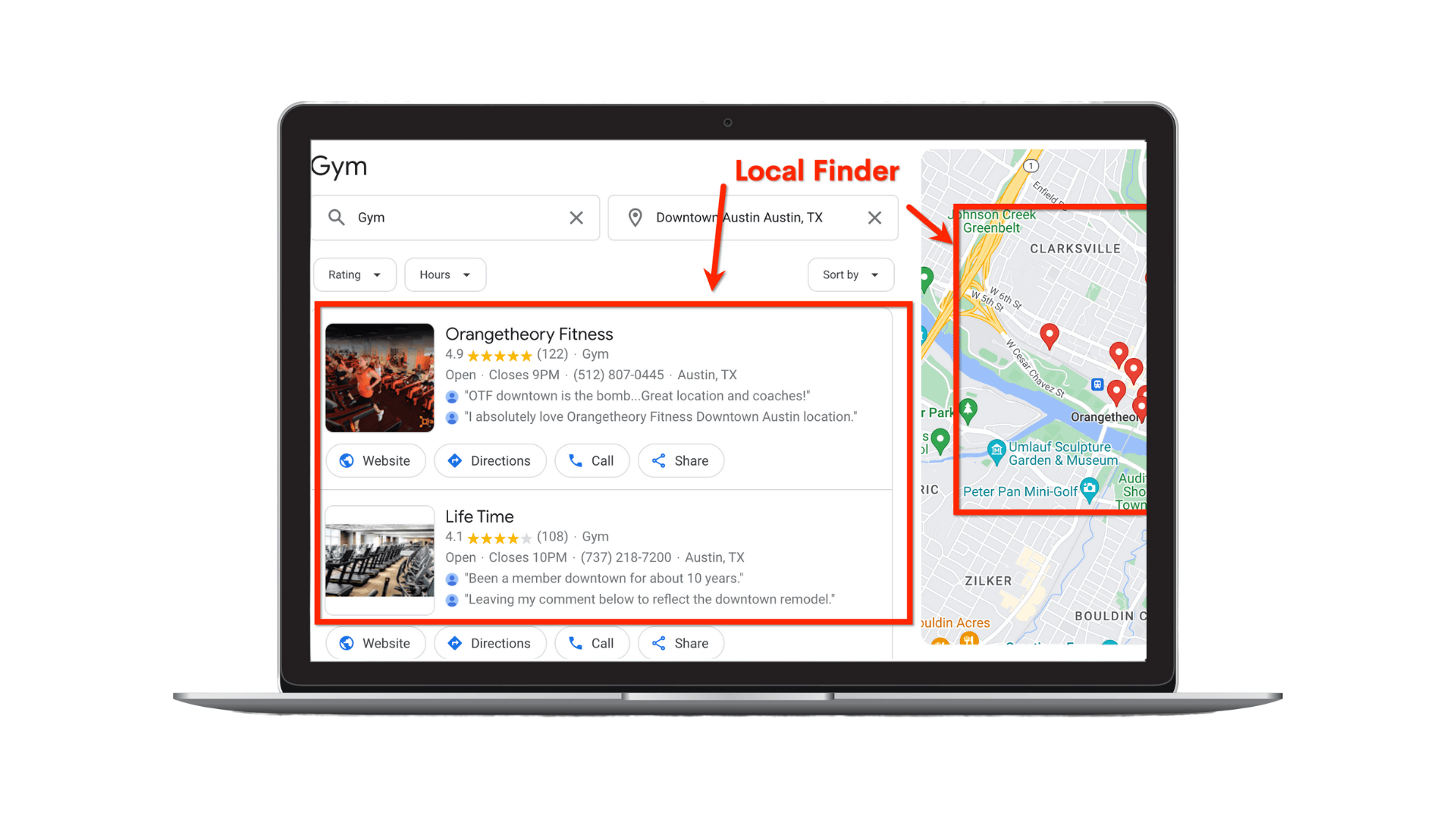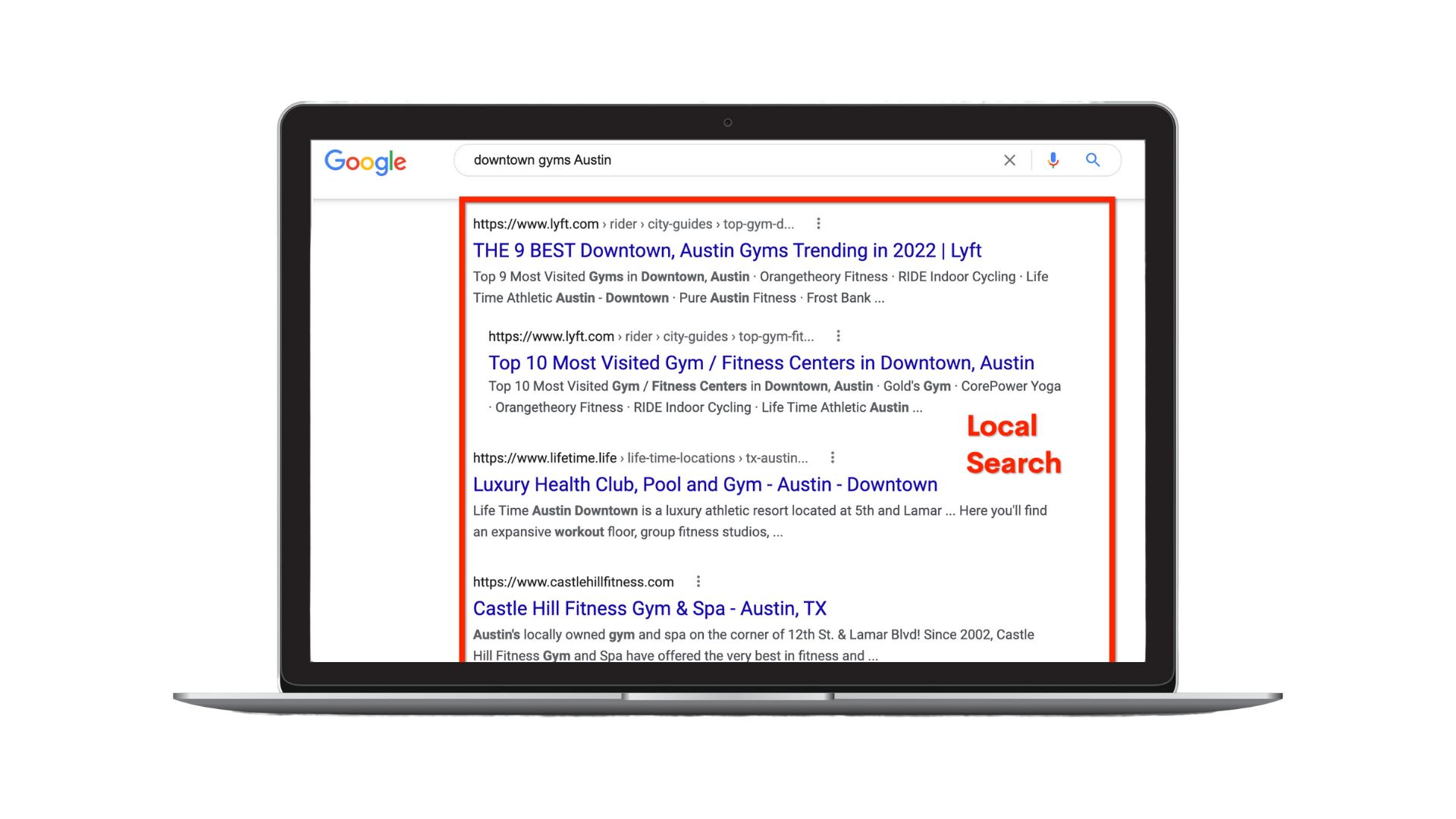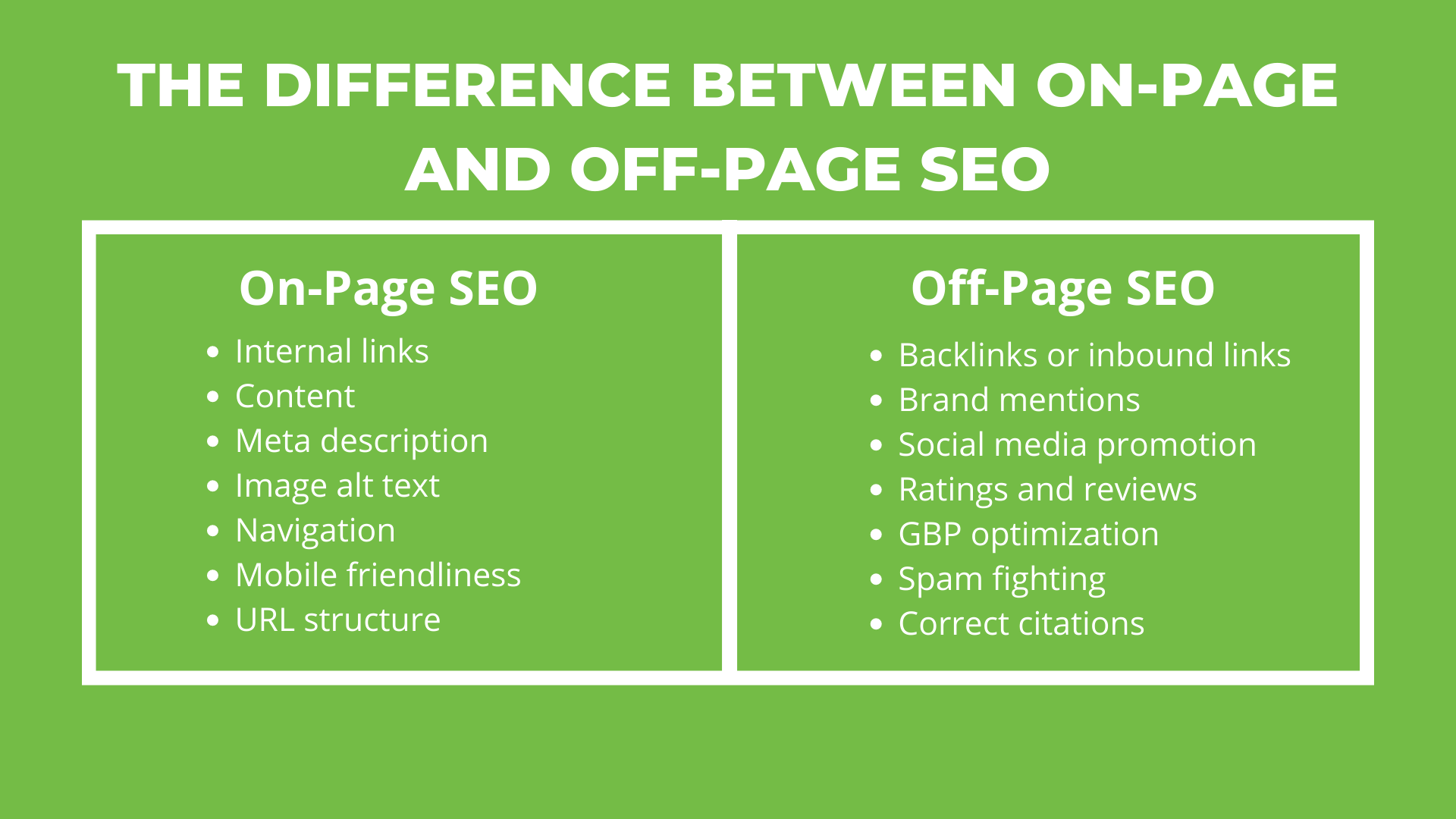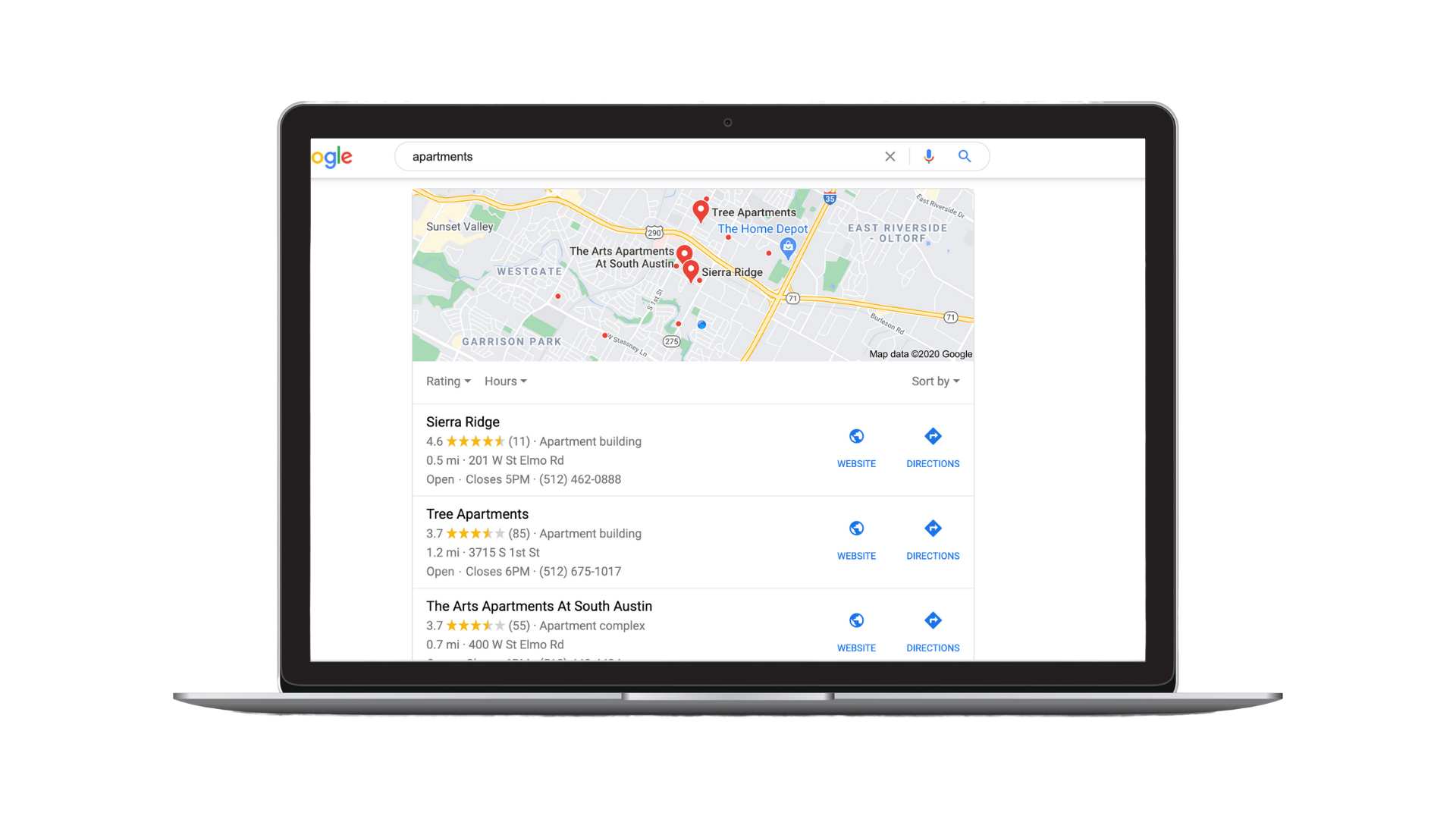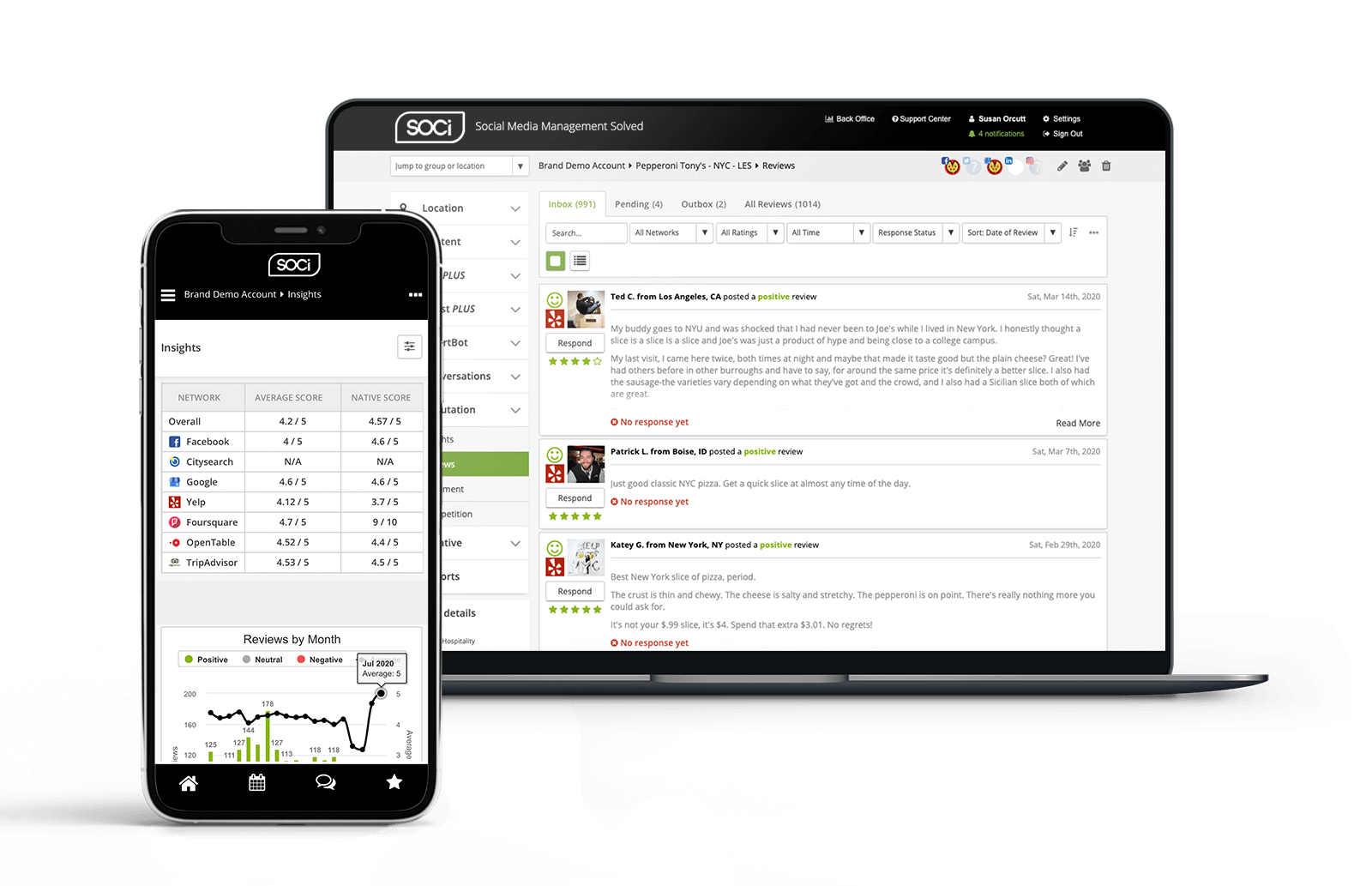The Ultimate Guide to Local SEO Ranking Factors
Google and other search engines continue to prioritize local search as more and more users are searching locally for products and services. Though estimates vary, Google representatives have stated that nearly half of searches are seeking something local.
To attract local customers, it’s imperative that your multi-location business rank in Google Search and Maps. Within this blog, we’ll focus on Google Search and how to get your local pages, Google Business Profile (GBP), and overall site ranking in the Local Pack, Local Finder, and local organic search.
There’s a lot of misinformation out there about local SEO ranking factors, but this blog should bring some clarity. You can use also use our local SEO checklist for your multi-location business when building out your own local SEO strategy!
Local Pack, Local Finder, and Local Organic Search Defined
To best optimize your company’s local SEO it’s essential to know the difference between the Local Pack, Local Finder, and local organic search. Here’s a breakdown of the three search types.
Local Pack
The Local Pack — also referred to as the Google 3-Pack — is a group of three local business listings that display in desktop or mobile search results when online users search locally for specific businesses or services. Read our article on ranking in the Google 3-Pack for a step-by-step guide to ranking in the Local Pack.
Local Finder
The Local Finder is what is revealed by Google and other search engines once you click “More places” or “More businesses” in the Local Pack in Google Search. Typically, at least 20 search results display in the Local Finder. On desktop, listings are shown in a left-hand panel with a map displayed on the right. Read our article on how local search works for a more detailed overview.
Local Organic Search
Local organic search, also referred to as local search or local organic, refers to the organic search results that typically appear after the Local Pack and ads sections. Occasionally, the Local Pack appears somewhere in the middle of the organic search results. General organic search lists sites relevant to your search query and typically includes directories, blogs, business websites, or review sites.
In some cases, the business website or local landing page of a Local Pack listing will also show up in the organic search results. Local organic search results are just like the results for any Google query, the only difference being that these results display content related to a particular location.
For instance, a search for “sushi” might offer non-local results about the history of sushi as a cuisine or common preparation methods, whereas a local search result for “sushi near me” might offer a link to a review site listing the best sushi restaurants in your area.
It’s worth noting that when you optimize your SEO efforts for the Local Pack you’re also optimizing for the Local Finder. The Local Pack is essentially the top three position in the Local Finder. It’s very desirable to be in the Local Pack as they receive 126 percent more traffic than businesses ranked 4-10.
Going forward, we’ll distinguish which local SEO tactics have a more significant impact on your rankings in the Local Pack/Finder or local organic search.
On-Page SEO vs. Off-Page SEO
Before diving into the ranking factors, it’s also important to know the difference between on-page and off-page SEO. Both SEO types work together in a complementary fashion to improve your search engine rankings. You have some control over both SEO types, but the tactics are quite different. Here’s a general breakdown of the two:
- On-page SEO is the process of making your website search engine friendly.
- Off-page SEO are activities that you and others do outside of your website to increase online visibility in relevant search results.
The chart below shows what SEO tactics or factors are considered on-page or off-page. When going through the ranking factors, we’ll also point out which fall under on-page vs. off-page SEO.
1. On-Page SEO
As mentioned earlier, on-page SEO is the process of making your website search engine friendly. For multi-location brands, the focus for local optimization should be the local landing pages for store locations. On-page SEO impacts local organic rankings more than Local Pack/Finder rankings, but it influences local rankings indirectly as well. According to the Whitespark Local Search Ranking Factors report for 2021, on-page SEO is the number one local organic search ranking factor and accounts for 34 percent of local organic ranking.
So, how can your multi-location business optimize its on-page SEO? Below are a few of the most useful on-page SEO tactics:
- Keywords: Add keywords judiciously to your website’s content, URLs, title tags, and meta description. Use a keyword tool like Ahrefs or Semrush to find competitor keywords. More on keywords in a later section!
- Title Tags: Place targeted keywords in your title tags. In general, title tags should not exceed 60 characters in length (including spaces).
- URL Structure: Include your primary keyword once in your URL structure and put hyphens between words. Optimize each URL on your domain.
- Meta Description: In your content management system, add a meta description, a 50-160 character hook that entices the reader. Meta descriptions appear below title tags on the search engine results page (SERP).
- Alt Text: Incorporate alt-text to images on your website. Alt text helps visually impaired internet users and search engines understand the content of your images.
- Internal Links: Add internal links across your entire website. Internal links are links from one page on your site to another internal page. Make sure you use relevant anchor text as well.
2. Google Business Profile
According to local SEO experts, optimization of your Google Business Profile (GBP) is the number one factor for ranking in the Local Pack/Finder. These experts believe that well-optimized Google profiles account for over a third of your ability to rank in the Local Pack/Finder. Your Google profiles can help rank in local organic search as well, but it more heavily impacts the Local Pack/Finder. According to Google, customers are 70 percent more likely to visit businesses with a complete GBP.
The recommendations below have a high impact on your Google profile(s) ability to rank. These recommendations fall under off-page SEO since they’re not on your company’s website.
Ensuring your multi-location business has the following in its Google profile(s) will help you rank in the Local Pack/Finder. They’re in order from most to least impactful.
- Primary GBP category
- Keywords in your GBP title
- Secondary or additional GBP categories
- Completeness of your GBP listing
- Keywords in GBP landing page title
Note that other GBP factors exist but are not listed. These are the primary ones. After optimizing the tactics mentioned above, the hard part is done! To maintain your GBP over time and encourage conversions, your business should keep hours of operation up to date, add high-quality photos, and create new Google Posts.
3. Backlink Profile
Backlinks are another major local SEO ranking factor. Backlinks are links from reputable sites to your domain’s pages. They signal to Google and other search engines that other websites value your site’s content.
It’s worth noting that acquiring backlinks is part of your off-page SEO strategy since backlinks come from outside your website. In addition, know that backlinks affect local organic search results more than your Local Pack/Finder rankings, but they can still influence those rankings.
Generally, you want backlinks from reputable sites such as:
- Local and industry publications
- Local directories
- Local blogs and event pages
- Local community websites
There are several ways to get links from reputable sites at both the national and local levels. Here are a few outreach methods for gaining backlinks:
- Partner with or host events with local nonprofits or organizations
- Invite local bloggers or review sites to your local businesses
- Hold events and have them published by local magazines and bloggers
- Hire a PR or a backlinks building service firm to gain authoritative backlinks
This being said, not all links are good. “Bad backlinks” exist, and they can hurt your domain’s ability to rank on the SERP. Therefore, it’s best to periodically check for and rid your website and local pages of spammy backlinks. Spammy links typically originate from the following:
- Links from link farms or directories
- Links from foreign language sites
- Links from websites that are entirely unrelated to your business sector
- Links from penalized domains
You can use the same keyword tools like Ahrefs or Semrush to monitor both good and bad backlinks. You can also disavow bad backlinks via Google.
It can be challenging for multi-location brands to build backlinks to their store landing pages, but this strategy may be particularly effective for franchisees who may be able to more easily establish connections in the local community that lead to backlinks, such as sponsoring a youth sports team.
4. Keywords
As mentioned earlier, keywords play a large part in your on-page SEO strategy, affecting your Local Pack/Finder and local organic search rankings. As a reminder, keywords should be in your website and local pages’ title tags, headers, and meta description.
Here’s a breakdown of the best keyword tactics to rank in the Local Pack/Finder and local organic search, and ranks them from most influential to least influential for Local Pack/Finder and local organic search. We’ve noted in parentheses which local ranking these keywords tactics affect more.
- Include relevant product or services keywords across your entire website (Local organic search)
- Be sure to focus both on competitive high-traffic terms and on niche terms that differentiate your business from the competition
- Be sure to focus both on competitive high-traffic terms and on niche terms that differentiate your business from the competition
- Put keywords in your GBP landing page title (Local organic search)
- Incorporate geographic keywords in your domain content (Local organic search)
- Place keywords in your GBP landing page H1 and H2 tags (Local organic search)
For more information on keywords, read our article on keyword strategy and research.
5. Online Reviews, Ratings, and Responses
Reviews are a key part of your off-page SEO strategy as well. Since 2015, there’s been a steady increase in the importance of reviews. In 2021, reviews accounted for 17 percent of your business’s ability to rank in the Local Pack and Finder, a prominent local search ranking factor. They were the second-largest factor behind optimizing your Google profile(s). Know that reviews affect local organic search, but minimally with only a five percent perceived influence.
It’s worth noting that when we say “reviews,” we include the review quantity, velocity, and diversity of first and third-party reviews (though Google reviews have the biggest impact). Since reviews occur off-site, they’re part of your off-page SEO strategy.
Here’s a breakdown of how reviews affect your Local Pack and Finder rankings:
- Positive reviews and ratings benefit your rankings the most. Positive reviews notify Google and other search engines that customers are pleased with the products and services you provide.
- Keywords in native Google reviews impact rankings as well. An example of keywords in reviews is if you’re a Thai restaurant and customers mention in their online reviews how good your “Thai food” is. You can’t necessarily control what keywords customers use in reviews, but if you have stellar products and services, that will influence which keywords customers use.
Remember that positive reviews and a high response rate across your local listings and GBP don’t just help with local SEO rankings. They also increase sales by showing customers that others enjoy your business and that you care about your customers enough to respond.
On the other hand, negative reviews can drop your SERP ranking and turn away potential customers, with more than half of consumers having passed up a business due to their local ratings and reviews. It’s worth noting that negative reviews happen occasionally, and one way to sway customers is how you respond to them. For a detailed guide on responding to reviews, download our Multi-Location Marketer’s Guide to Online Reputation Management.
If you need help managing and responding to reviews across all of your business listings, consider using SOCi’s reputation management software. SOCi’s reputation management software helps you monitor reviews across all major reputation and review networks and allows you to prioritize and customize all of your responses.
Secondary Local SEO Ranking Factors
The three factors below are all secondary to the ones discussed above. They’re secondary local SEO ranking factors because companies have less ability to control them. However, they’re worth understanding.
We’ll discuss what each factor means and how your multi-location business can make minor modifications with each to improve your SEO.
6. Behavioral Signals
Google and other search engines’ algorithms have several behavioral signals to help determine local organic search and Local Pack/Finder results, but primarily local organic search.
Behavioral signals are online users’ actions that indicate how they engage with your local business listings, pages, and primary domain. Since online users are behind these behaviors, you can only influence them indirectly.
The primary behavioral signals that affect local SEO rankings are:
- Click-through rate (CTR): Clicks from online searches
- Social media check-ins: Consumers using social media “check-in” at your company’s store or physical location.
- Mobile clicks to call: When online users use your website’s call-to-action (CTA) button or phone number that directly calls a local business
7. Citations
A “citation” is any mention of your business on a third-party website. For local SEO purposes, the term generally refers to structured citations, which are business listings presented in a directory format. Yelp would be an example of a site offering business listings that may be indexed by a search engine like Google.
Years ago, citation building was considered to be a critical local SEO strategy. This strategy consisted in building out consistent, accurate listings for your business on as many third-party directories as possible. In the early days of local search, Google relied heavily on these sources to determine how to rank local results.
Today, with Google and a few other sites getting the lion’s share of local traffic, citation building has diminished in importance, but it’s still a good idea to ensure that your business is listed on a broad base of sites and directories, especially those that may be frequented by consumers in particular niches and geographies.
The best way to ensure your local listings have correct citations is to contact one of the three leading data aggregators, Acxiom, Localeze, or Foursquare with the most up-to-date and factual NAP citations. To make the process easier, consider using SOCi’s Listings software, which integrates with the above-mentioned data aggregators and others. SOCi Listings software makes it easier to manage your location data across all of your online and media platforms.
8. Personalization
Google and other search engines factor in a user’s personalization as part of local SEO rankings. Individual personalization includes a user’s search history, location during a search, and the type of device used. Other factors include preferred language and the type of sites a user typically visits.
Personalization affects local and organic search results and has about a five percent total impact on both. However, multi-location businesses can’t do a lot to optimize personalization except for multilingual SEO.
Multilingual SEO falls under on-page SEO, and includes personalizing your local pages or website for languages specific to a geographic region. For instance, if one of your business listings is in a predominantly Latin American community, you can optimize your local landing page’s content and keywords for Spanish-speaking users. For more detailed information on how to implement multilingual SEO, read this article.
What Doesn’t Affect Local SEO
There are a lot of myths about local SEO ranking factors. It’s good to know these myths, so you don’t waste time and energy on tactics that don’t work. According to local SEO experts, here are the top local SEO myths that don’t directly impact your local SEO rankings:
- Geo-tagged photos uploaded to your GBP
- Keywords in GBP description
- Keywords in GBP products and services
- Frequency of Google Posts posted
- Keywords in Google Posts
It’s important to note that even though these factors don’t affect local SEO rankings, it doesn’t mean they aren’t good for your business. Many of these are helpful from a user experience perspective and can draw online users to your listings and Google profiles.
Start Boosting Your Business’s Online Visibility
Clearly, there’s a lot that goes into local SEO success. Hopefully, this blog has helped inform you on which steps to take to optimize your local SEO strategy. Remember, general and local SEO are constantly changing, and you need to make adjustments accordingly.
While you now understand what it takes to improve your business’s online visibility, our Top 10 Things You Should be Doing in Local SEO Now guide provides additional tactics to boost your local SEO efforts.
If you need to locally perfect your GBP, local listings, or local pages, SOCi is here to help. SOCi is the marketing platform for multi-location brands, and can help improve your localized marketing strategy while saving your team time and effort. For more information, request a demo today!
